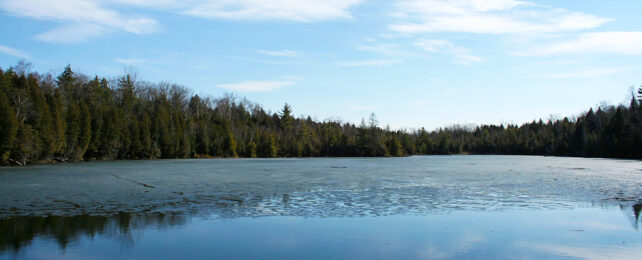Like the pages of a diary hidden beneath a child's bed, the floor of Crawford Lake in Ontario, Canada, preserves Earth's most recent memories in clear, chronological order.
The story within its laminated sediments is dominated by humans, detailing at an annual resolution the activities of local Iroquoian communities in the late 13th to 15th centuries, through the arrival of the European colonists to today.
For this reason, a team of experts nominated the UNESCO Biosphere Reserve as the site that ought to represent the start of the Anthropocene epoch.
Though yet to be officially accepted as a unit of geologic time, the Anthropocene is defined by the large-scale changes our species has forced upon the planet's surface.
In 2016, a working group under the guidance of an International Commission on Stratigraphy subcommittee agreed that human behavior has left scars so deep they will remain evident far into the future.
Long after our buildings have crumbled and our roads are overtaken by wilderness, there will be geological features, radioactive isotopes, chemical concentrations, and dramatic shifts in the fossil record signifying our presence.
Whether these deviations will remain obvious enough to warrant an epoch of their own remains a topic of ongoing debate. Even if they do, which of them deserves pride of place as the starting line of the Age of Humans?
While Homo sapiens have dramatically shaped the natural world for thousands of years through hunting, burning, and building, few flags could be as clear and enduring as the thin blanket of radioactive material that appeared in the mid-20th century.
"The presence of plutonium gives us a stark indicator of when humanity became such a dominant force that it could leave a unique global 'fingerprint' on our planet," says Andrew Cundy, Chair in Environmental Radiochemistry at the University of Southampton and a member of the Anthropocene Working Group (AGW).
"In nature, plutonium is only present in trace amounts. But in the early-1950s, when the first hydrogen bomb tests took place, we see an unprecedented increase and then [a] spike in the levels of plutonium in core samples from around the world. We then see a decline in plutonium from the mid-1960s onwards when the Nuclear Test-Ban Treaty came into effect."
Agreeing on a simple measure that defines the boundary between chapters in Earth's history is just the first step. To truly ensure every scientist is on the same page, this measure needs to be tied to observations at a single location.
Known as the Global Boundary Stratotype Section and Point, or a golden spike, this site standardizes the borders between epochs and their stages, be it a sudden change in color in layers of rock in Oued Akrech, Morocco, or the sudden vanishing of tiny organisms in a fossil bed near Alano di Piave, Italy.
The AGW has spent the past three years assessing the qualities of a dozen potential golden spikes for the Anthropocene, working through the challenges of a global pandemic to collect evidence and collaborate on the merits of each site. Finally, the working group has whittled their selection down to just one.
"Crawford Lake is so special because it allows us to see at annual resolution the changes in Earth history throughout two separate periods of human impact on this small lake," micropaleontologist Francine McCarthy of Brock University in Canada, a voting member of the AGW, said at a press briefing.
Being so small and deep, the lake's waters don't mix easily. Calcium and carbonate from nearby rocks dissolve in its waters and combine in warm weather to form crystals that settle on the floor, defining each season. The pollen, soot, and assorted isotopes trapped within these layers annotate the human activity in centuries recently gone.
"The sediments found at the bottom of Crawford Lake provide an exquisite record of recent environmental change over the last millennia," says AGW secretary Simon Turner, a geoscientist at University College London.
"It is this ability to precisely record and store this information as a geological archive that can be matched to historical global environmental changes which make sites such as Crawford Lake so important."
For the Anthropocene to earn its place in the International Chronostratigraphic Chart, its golden spike must pass through a succession of voting by a hierarchy of commissions and unions.
If it does, the cool, deep waters of Crawford Lake will officially define the moment when humans changed our planet forever.
